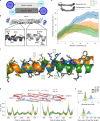Genome-wide association analyses of physical activity and sedentary behavior provide insights into underlying mechanisms and roles in disease prevention
- PMID: 36071172
- PMCID: PMC9470530
- DOI: 10.1038/s41588-022-01165-1
Genome-wide association analyses of physical activity and sedentary behavior provide insights into underlying mechanisms and roles in disease prevention
Abstract
Although physical activity and sedentary behavior are moderately heritable, little is known about the mechanisms that influence these traits. Combining data for up to 703,901 individuals from 51 studies in a multi-ancestry meta-analysis of genome-wide association studies yields 99 loci that associate with self-reported moderate-to-vigorous intensity physical activity during leisure time (MVPA), leisure screen time (LST) and/or sedentary behavior at work. Loci associated with LST are enriched for genes whose expression in skeletal muscle is altered by resistance training. A missense variant in ACTN3 makes the alpha-actinin-3 filaments more flexible, resulting in lower maximal force in isolated type IIA muscle fibers, and possibly protection from exercise-induced muscle damage. Finally, Mendelian randomization analyses show that beneficial effects of lower LST and higher MVPA on several risk factors and diseases are mediated or confounded by body mass index (BMI). Our results provide insights into physical activity mechanisms and its role in disease prevention.
© 2022. The Author(s).
Conflict of interest statement
C.F. is Vice President and Head at Genetics and Pharmacogenomics, Merck labs. M. Lorentzon has received lecture or consulting fees from Amgen, Lilly, UCB Pharma, Radius Health, Meda, GE-Lunar and Santax Medico/Hologic. P.V. received an unrestricted grant from GlaxoSmithKline to build the CoLaus study. These authors played a role in individual studies that contributed to the meta-analysis, but not to the meta-analysis of GWAS studies, downstream experiments and analyses, or interpretation of the data. Hence, it is highly unlikely to have influenced the results of this study. The remaining authors declare no competing interests.
Figures











References
-
- Global Action Plan for the Prevention and Control of Noncommunicable Diseases 2013–2020 (World Health Organization, 2013).
Publication types
MeSH terms
Substances
Grants and funding
- MC_UU_00007/10/MRC_/Medical Research Council/United Kingdom
- RG/13/13/30194/BHF_/British Heart Foundation/United Kingdom
- R01 DK107786/DK/NIDDK NIH HHS/United States
- R01 DK075787/DK/NIDDK NIH HHS/United States
- R01 NS100178/NS/NINDS NIH HHS/United States
- SP/16/4/32697/BHF_/British Heart Foundation/United Kingdom
- R01 HL151152/HL/NHLBI NIH HHS/United States
- BRC-1215-2001/DH_/Department of Health/United Kingdom
- U01 DK062370/DK/NIDDK NIH HHS/United States
- MC_UU_00006/1/MRC_/Medical Research Council/United Kingdom
- R01 HL143885/HL/NHLBI NIH HHS/United States
- 217065/Z/19/Z/WT_/Wellcome Trust/United Kingdom
- RG/18/13/33946/BHF_/British Heart Foundation/United Kingdom
- R01 HG009974/HG/NHGRI NIH HHS/United States
- U01 AG070959/AG/NIA NIH HHS/United States
- MC_UU_00006/4/MRC_/Medical Research Council/United Kingdom
- MC_UU_00011/MRC_/Medical Research Council/United Kingdom
- R01 HL142302/HL/NHLBI NIH HHS/United States
- R01 DK110113/DK/NIDDK NIH HHS/United States
- C18281/A19169/CRUK_/Cancer Research UK/United Kingdom
- R01 DK062370/DK/NIDDK NIH HHS/United States
- R01 HL105756/HL/NHLBI NIH HHS/United States
- P30 ES007033/ES/NIEHS NIH HHS/United States
- R01 DK101855/DK/NIDDK NIH HHS/United States
- R01 NS114045/NS/NINDS NIH HHS/United States
- P30 DK020541/DK/NIDDK NIH HHS/United States
- CH/12/2/29428/BHF_/British Heart Foundation/United Kingdom
- R01 DK124097/DK/NIDDK NIH HHS/United States
- R01 NS105150/NS/NINDS NIH HHS/United States
- R01 DK089256/DK/NIDDK NIH HHS/United States
- P30 DK020572/DK/NIDDK NIH HHS/United States
- WT_/Wellcome Trust/United Kingdom
- R01 HD057194/HD/NICHD NIH HHS/United States
- R01 HG010297/HG/NHGRI NIH HHS/United States
- U01 CA164973/CA/NCI NIH HHS/United States
- 202802/Z/16/Z/WT_/Wellcome Trust/United Kingdom
- 29019/CRUK_/Cancer Research UK/United Kingdom
- R01 HL149683/HL/NHLBI NIH HHS/United States
- BRC-1215-20010/DH_/Department of Health/United Kingdom
- UM1 CA182876/CA/NCI NIH HHS/United States
- R01 DK122503/DK/NIDDK NIH HHS/United States

